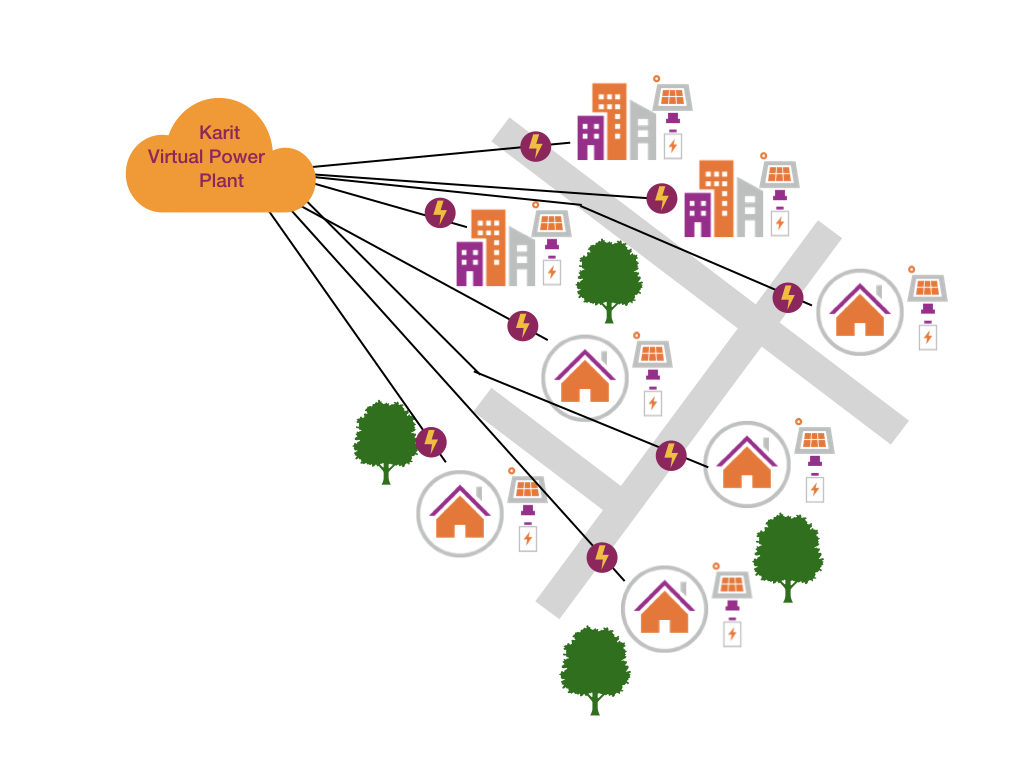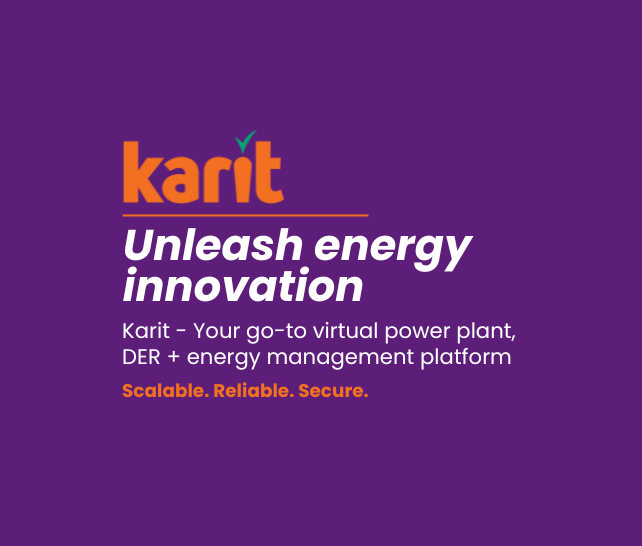
What Is a Virtual Power Plant?
A virtual power plant (VPP) is essentially a network of decentralised and distributed energy resources (DER) managed by a central control platform. This includes solar PV, wind turbines, battery storage, EV charges and electric vehicles.
The central control platform enables large numbers of DER to be orchestrated across different locations and work together like a traditional centralised power plant. A VPP is a more effective and efficient way to manage distributed energy resources and dynamic energy flows.
It’s important to note that there are very different types of VPP technology available.
The most basic simply control inverters and batteries via an API or an IoT device to manage peak demand. The more sophisticated, such as Karit, use software informed by machine learning to carry out forecasts, efficiently manage and optimise the assets and devices connected to the VPP dynamically.
How does a Virtual Power Plant work?
Renewable energy sources
Renewable energy generation and storage sources are installed at selected locations.
Aggregation
Decentralised distributed energy resources (DER) are combined into a single system using advanced software platforms. This is referred to as aggregation. A variety of DER can be incorporated into a VPP. These include renewable energy sources, such as solar and wind generation, or controllable loads, such as battery storage and EV charges.
Real-time data
Sites are connected to a VPP using an IoT device which connects the DER to the VPP cloud. The VPP operator uses the cloud-based platform to centrally control and monitor the performance and availability of the aggregated resources in real-time, maximising production and optimising consumption efficiency.
Optimisation and energy management
VPPs are designed to extract the greatest value from the aggregated energy resources. Parameters and triggers are set so that energy is dispatched from the most appropriate sources to meet demand, minimise costs and ensure grid reliability. For example, when electricity prices are high or during peak demand periods, the VPP will initially dispatch from renewable generation sources or batteries.
The VPP platform provides the ability to settle and reconcile the energy production and consumption between the locations connected to the VPP. So, if one site within the VPP produces more energy than needed, the excess energy can be redistributed to other sites that require more. This helps to balance out the overall energy usage within the network. Learn more about energy management.
Intelligent VPP platforms, such as Karit, use advanced algorithms and machine learning to optimise the performance and dispatch of resources. Factors such as energy demand, grid stability, market prices, and weather forecasts are incorporated into renewable energy forecasting models. Learn more.
Integration with energy markets
VPPs can participate in energy markets, they can dispatch surplus energy back to the grid or offer ancillary services like demand response and frequency control. This creates income opportunities for the owners of the distributed energy resources, and also helps to maintain a balance between energy supply and grid demand. Learn more.
Performance monitors
Advanced VPP platforms, such as Karit, also serve as an asset management system. They optimise the overall performance and lifetime of the distributed renewable energy resources to meet customer and market commitments. Learn more.
What are the benefits of a Virtual Power Plant?
Generally, with small and midsize enterprises and residential properties, a VPP is designed to create value for both the VPP operator and participants. Usually, they share the financial benefits the VPP creates.
For larger commercial and industrial enterprises, deploying a VPP creates the potential to:
- Gain greater control over decentralised distributed energy resources
- Improve asset efficiency and performance
- Manage the full lifecycle of renewable energy assets
- Contribute to grid stability and reliability
- Share energy from one site with another site in the VPP portfolio spreading the economic benefit of distributed renewable technologies
- Reduce energy costs
- Participate in energy markets
- Easily adapt to changes in energy demand and adopt new technologies
- Reduce carbon emissions
Creating a Virtual Energy Community or Virtual Power Plant means that you can gain the benefits of bringing together distributed energy resources in a more effective manner.
Effective. Sustainable. Efficient.
Who can benefit from a VPP?
Individuals, businesses and communities can all benefit from the deployment, participation in, and promotion of Virtual Power Plants.
- Energy producers/generators and DER owners – can maximise revenue by selling excess energy at optimal times and providing grid stabilisation (ancillary) services.
- Commercial, industrial, and residential consumers with flexible loads or storage assets – can earn incentives by adjusting their energy consumption patterns or selling stored energy back to the grid during peak demand periods.
- Utilities and grid operators can enhance grid reliability and stability by aggregating diverse energy resources through VPPs.
- Microgrid operators can optimise their distributed energy resources by participating in VPPs. A VPP enables them to balance local supply and demand, reduce energy costs, and enhance grid resilience during outages or emergencies.
- Energy service providers and aggregators can leverage VPPs to offer value-added services to their clients, such as energy management, demand response, and virtual energy trading. By aggregating multiple resources, they can optimise energy portfolios and unlock new revenue streams.
- Governments and regulatory bodies can promote VPP participation as an energy policy initiative to achieve sustainability goals, improve energy efficiency, and support the transition to a decentralised energy system.
Virtual Power Plants are the future of energy
Interested in extracting value from the biggest change to the energy industry in over 100 years? Thinking about changing the way you provide energy to your customers, communities and business?
Learn how a Virtual Power Plant powered by Karit can benefit you and your organisation
Watch our short explainer video to learn about the benefits of a Karit Virtual Power Plant.
How does a VPP powered by Karit work?
Karit is a cloud-based command and control platform that connects with our specifically designed edge energy management devices (we call them Karit Cakes). These devices collect energy and asset data, and enable commands to be sent between the control platform and the distributed energy assets. The Karit platform is integrated with real-time weather and energy market data. This integration provides a framework for intelligent management, and optimisation of energy flows and VPP performance. A market settlement arrangement is established so excess energy from VPP generation sites can be utilised at other sites or traded dynamically in energy markets.
Real-time data
Performance monitors
Market predictions
Efficient & sustainable
Why deploy a VPP with Karit?
The Karit Advantage
We’re transforming how energy is managed.
A Virtual Power Plant powered by Karit is the solution to efficiently adding distributed energy resources (DER) into the grid and creating self-sufficient energy ecosystems.
Our platform empowers our customers to aggregate and coordinate large numbers of DER, including wind, solar, battery storage, EV charges and more.
With Karit, you can harness the combined strength of disparate and decentralised energy assets to:
- Interact with energy markets
- Improve energy efficiency
- Optimise asset performance and return on investment
- Secure energy supply
Karit delivers enhanced features
Technology-agnostic platform
Embrace a platform that accommodates a variety of DER makes and types—whether it's generation or storage, our technology is adaptable and scalable.
Seamless integration
Our platform fully integrates with energy market and weather services, enabling predictive event management.
Tailored operating modes
Use specific operating modes for individual sites or groups within the Virtual Power Plant to enhance energy and asset efficiency.
Unified asset management
Manage your distributed energy resources cohesively as a single entity, enabling intelligent interaction with energy markets. And that's just the beginning.
Discover what Karit’s advanced energy management tools can do for you
Control your energy and asset management effectively with one secure and scalable platform
- Greater value from distributed energy assets
- Modern integrated and managed system
- A simple licensing model
Revolutionise your energy management today with Karit
Get the technology, tools and expert support you need to uplevel your energy and asset management.
Looking to deploy a Virtual Power Plant?
VPP Solution Partner Program
For solution providers
- Solar, Storage, EV charging installers
- Hardware manufacturers
- Energy service providers
Energy Partner Program
For energy organisations
- Retailers
- Distributors
- Gentailers
- Vertically Integrated Operators
Questions? We’re here to help.
